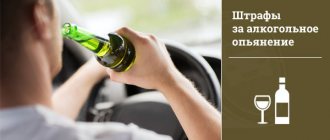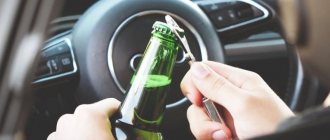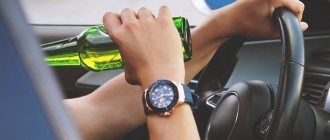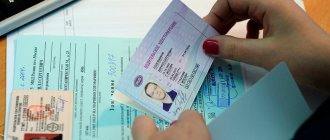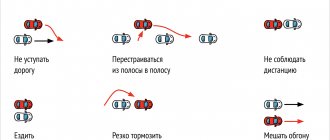Let's try to decipher the secret alphabet of driver's licenses. First, let's pay attention to the official marks on the license. They openly inform about what types of transport the holder of this license is allowed to drive. Let's take a closer look at the rights. It turns out that there are also other marks on them - unofficial ones. They are worth paying close attention to. Let's try to understand this secret writing.
Labels on licenses - what are they? Upon closer examination of some of the IDs, it turned out that they were marked with small and large holes, various embossed signs and dots. These badges most likely appeared during a meeting with inspection staff. This was done, of course, in secret from the driver. Such marks are placed on the license with a needle or pen.
The mystery of the marks on the license is revealed. Each area of the driver's license is intended for certain marks. The most popular place is photography. There are no instructions anywhere for unraveling the true meaning of each mark, so the same signs may have different interpretations. But let’s still get acquainted with the most popular tags.
What do the marks on the eyes say? If a mark is placed on one eye or both eyes, then it should be understood this way: the owner of the ID can easily be enraged. He is aggressive, swears, and can get into fights. Harmfulness - one eye, too much harm - both eyes.
The owner's greed is marked with a pen with two dots below the eyes.
If the area of the left eye is marked with a puncture, then you will get nothing from the owner except swearing, if the right eye, he will give money without swearing.
What does the nose “say”: the mark on the nose screams that the driver was detained while driving drunk, and a large sum of money was received.
The secrets of ear markings. Ears are marked in two cases:
- if the driver has good legal training, and the traffic police lost him one (puncture of one ear) or many (puncture of both ears) trials;
- if the driver is greedy.
What is “written on the forehead”. It turns out that the marks on the forehead have opposite meanings. They are put on the rights of a driver who gives a bribe, and on the rights of a very greedy owner. You can also read from the mark on the forehead that the driver did not respond to the inspector’s request to stop.
If the mouth is marked. A marked mouth is an angry driver who loves to swear.
About other marks Other marks mark various places on the driver's license. It is difficult to say about their true meaning, but it can easily be argued that if they are present, a meeting with an inspection employee does not bring anything good. Please note that there are many marks, but their meaning is the same - the owner did not please the inspector.
Who marks rights and why Marks on rights are a kind of mail for those who are privy to its secret writing. With its help, state traffic police officers transmit information about the driver to each other, which allows them to receive the largest amount of money.
Getting rid of marks Some amendments to the license are possible using available means, but the simplest and most logical way to get rid of marks on a license is to replace the driver’s license.
Save yourself Of course, today there are many unscrupulous inspectors who strive to “cut money” from the driver, but if everything is in order with your documents and the vehicle itself, there is nothing to be afraid of. To avoid the presence of marks on your license, strictly follow the traffic rules, remain calm when communicating with the inspector, be polite and patient. Keep your driver's license in a plastic pocket and present it to the inspector. In general, be careful!
What are the labels on a license?
The stamps on your driver's license may look different. These can be small depressed points from a sharp object, holes from a needle or awl, or points from a fountain pen. They usually appear after communicating with a traffic police inspector. Of course, such signs are not placed in front of the car owner. Most often this happens when inspectors are working together with you. One communicates with the driver, for example, checks the car, asks to show the contents of the trunk, go to a checkpoint or inspection booth, while transferring his license to the second.
Concept of marks on driver's licenses
Once upon a time, traffic inspectors organized their own secret movement against drivers and began to put special marks on their driver’s licenses that were understandable only to each other.
Why are such labels needed on licenses? Then, when checking, a traffic cop is able to evaluate a person’s actions in a non-standard situation, his personal qualities in connection with a certain assessment. This or that mark on the license is placed unnoticed by the driver himself.
There are many methods for applying marks to a driver’s license, we will discuss them below. As a rule, such marks appear after the driver meets with the traffic police inspector. Naturally, such marks are not placed in front of the vehicle owner. Most often they are placed when inspectors work in pairs:
- one approaches the driver and checks the car or inspects the contents of the trunk;
- the second receives a driver's license from his partner, goes to the inspection booth or post, and puts a certain mark in it.
What do they mean?
The meaning of the marks on a driver's license depends on where they are located on it. Most often, a photograph of the driver is used to transmit “secret data,” but marks can also be found in other places. Still, most often, traffic police officers put marks on the image of the owner.
Eyes
An inspector may leave marks on one or both eyes on the driver’s license in the following cases:
- Mark in the area of the left eye - a scandalous person, does not give bribes, swears. In the area of the right eye - the driver pays the money without further ado, calm.
- Two dots under the eyes tell the inspector that the person in front of him is greedy, you won’t get money from him
- The eye is marked - the driver is principled and “harmful”. Both eyes are marked - super harmful. It can mean “major” or “son”, who is hiding behind someone’s patronage.
- Marks on the eyes can be placed in cases where the driver is aggressive, he is easily thrown off balance, and in an acute situation it can even lead to a fight.
The specific meaning will emerge when talking with the inspector; remember, he is already prepared for one of these situations.
Ear marks are most often placed for the following reasons:
- The person is legally savvy, a lawyer. Won a lawsuit (piercing in one ear) or several lawsuits against the traffic police (piercing in both ears). In an ambiguous situation, it is better not to mess with this.
- The owner of the ID is greedy and you won’t get any money from him. In case of obvious violation, an official fine will have to be issued.
Marks with simultaneous indications of the eyes and ears mean that in front of the inspector is a “Judas” - a person who can record audio or video. Such marks on the license and their meaning tell the traffic police officer that he needs to be especially attentive and careful with him.
Markings on the nose are not interpreted so differently. In almost one hundred percent of cases, they mean that the car owner is a “military” person who was once caught drunk or committed some other serious violation and paid off with a large sum. He offers a bribe himself; there is no need to hint at a “peaceful solution to the problem.”
Marks on the forehead of an inspector can be given to a person who “bulls”, bargains with an employee, is greedy, but, nevertheless, strives to pay off in case of violations. With this, if you have persistence and free time, you can get a bribe.
Marks near the driver's mouth are not so common. The most common interpretation of a marked mouth is considered to be the driver's integrity or scandalousness and viciousness. Inspectors have to issue an official protocol to the “tagged” person - there will be no bribes.
A dot on the neck means that a person, as they say, “uses.” The inspector understands that the man in front of him is a drinker and has already been caught for this offense, but paid off. Unscrupulous inspectors can carry out a provocation, using various tricks to “bring” the driver under the article for drunk driving.
Find out about the car's VIN code in another article.
Breast
A dot on the chest means a person with a “heart.” This is usually a minor offender, communicates with inspectors cheerfully and peacefully, and jokes. This person can be fined, or he can be released. In any case, a conversation with such a driver is a little entertainment in routine work.
In the prevailing unspoken rules of “road peace officers,” there may be other marks on the license, and their meanings in the owner’s photo may vary in different regions. But one thing can be said for sure - like a pirate “black mark”, they do not promise anything good when meeting with the traffic police - they mean that during previous conversations with inspectors the person “distinguished himself” in some way, did not agree with them and tried to challenge his violation.
Location value
And now the most interesting thing is deciphering secret signs, because they are applied for a reason, but as a specific message intended for other representatives of law and order. Conventionally, these marks can be divided into two groups, each of which has its own meaning.
Designations in the photo
Most often, inspectors characterize drivers by placing dots on their photographs in certain places on their faces on their licenses.
And where exactly these marks will be placed should be the starting point when deciphering their hidden meaning:
- Neck. A puncture under the chin is a sure sign that the motorist has been repeatedly detained and prosecuted for driving while intoxicated or on fumes.
- Ears. Points in this area indicate the driver’s legal knowledge, as well as his ability to clearly defend his position, appealing to traffic rules.
- Mouth. Such marks characterize the person to whom they were given as an exceptionally scandalous person, capable of the most reckless antics in controversial situations.
- Eyes. Marks on the pupils or in the corners indicate that the motorist has a reliable patron and, as they say, the law is not written to him.
- Nose. If a driver stopped on the road has such a point on his license, then most likely the inspector is facing an inveterate violator who willingly pays bribes, trying to solve problems on the spot.
- Forehead. Such motorists act head-on, showing particular intractability in controversial situations and bargaining until the last minute if the fact of a violation becomes obvious.
- Breast. As a rule, such violators are willing to make deals with inspectors, trying to resolve even the most difficult situations peacefully.
- Eyes and ears. If an inspector suddenly notices two marks, then he should be extremely careful, because in front of him is a provocateur who is capable of deliberately making law enforcement officials emotional by making hidden audio or video recordings.
Of course, any notes of this kind are illegal. Moreover, an unfair point can greatly annoy the driver, causing a biased attitude towards him from other inspectors.
See also:
Why shouldn’t you worry too much if you forgot your license at home?
Mysterious letter "K"
It’s even worse if the letter “K” is suddenly indicated on the certificate. It is noteworthy that it can not only be scratched with a needle, because many traffic police officers prefer to limit themselves to underlining this letter in any word. Some go even further by painting horns on the driver. All these are derivatives of one meaning - “Goat”, because this is how inspectors mark aggressive drivers who provoke conflict at any cost.
Why do traffic police officers mark your license?
Tags on licenses, both new and old, convey information that is easily read by traffic police inspectors. With their help, they convey tips to each other, characterizing the driver from the side they need in order to obtain the greatest benefit. Tags save them time by immediately preparing inspectors for a situation that is beneficial to them.
You probably immediately decided to check your rights after reading the article. And some were able to discover “mysterious” signs there. So what's now?
Reasons for the appearance of marks on a driver's license
To punish unyielding motorists, traffic police inspectors leave secret signs. In this way, traffic cops learn about the possibility of receiving a bribe. The marks indicate a person’s tendency to conflict. The likelihood of receiving such signs increases if the car is stopped by several police officers at once. During the inspection, the inspector can apply certain marks unnoticed by the driver.
Any sharp object is suitable for making marks. With their help, the policeman punctures in the right place. You can use a ballpoint pen to mark the offender’s document. The inspector only needs to press in a certain place on the photo of the offender. The mark will remain even if the car owner wipes off the paste. Most often, an awl or needle is used to make indentations.
Indentations on the document may cause the machine to stop constantly. Traffic cops take into account the legal knowledge of citizens and their ability to defend their position. With the help of secret signs they not only exchange information. Traffic cops want to earn more money without getting involved with scandalous individuals.
How to get rid of tags
There are many ways to do this. The simplest and most reliable of them is replacing a driver’s license. Of course, knowing about the marks on your license and their meanings, you can try to make “amendments” yourself, and even identify yourself as a principled “lawyer.” But experience says that this should not be done. With such an adjustment, you may not only fail to remove old tags, but also accidentally add new ones, adding yourself to unexpected categories of violators.
How to restore numbers, read here.
What do the marks mean?
What marks do traffic cops put on their licenses and where to look for them? Most often, special symbols appear in the area of the photograph of the document owner. This secret tradition began several decades ago, but continues to exist today. Inspectors place marks on certificates most often in the following places:
- in the ear area;
- on the forehead;
- before our eyes;
- in the area of the nose;
- on the lips.
So, if a mark appears on the lips, this may mean that the owner of the document likes to argue or often creates conflict situations. As a rule, traffic inspectors do not like such drivers.
The designation of a dot on the driver’s license in the forehead area indicates that the driver is greedy, but if necessary, he can agree to a bribe. Such a mark may also indicate that the driver has a habit of not responding to the demands of traffic police representatives.
Punctures or dents in photographs taken in the eye area are a sign of character complexity. It is intended to tell other inspectors that the owner of the rights is inclined to act aggressively, easily loses his temper and may even resort to assault.
Markings under the eyes indicate tightness and indicate that the driver will not give a bribe under any circumstances. A puncture in the area of the right eye is intended to notify inspectors of the calmness of the driver, as well as the readiness to resolve the issue on the spot.
Marks left on the ears speak not only of greed, but also of the legal savvy of the owner of the rights. Inspectors pierce both ears to warn colleagues that the driver was suing the traffic police and even won the case. Markings in the nose area are a sign that the driver likes to drive while drunk and will try to resolve the issue with a large bribe.
On the Internet you can find many photos with marks on the driver’s license and their meanings. Among them there are rights with letter designations.
For example, the letter K is a sign by which you can recognize the owner who has offended the inspector in some way. Such drivers are not particularly favored at the next stop, trying to issue maximum fines.
How to protect your rights from tags
The best way to protect your rights is not to break the rules. However, there are situations when unscrupulous inspectors try to accuse you of violations that you did not commit. In these cases, it is necessary to behave with restraint and calm, not to shout or make trouble.
If you do not feel able to communicate peacefully with the traffic police, then try storing your driver’s license in a plastic case. And in it, give the rights to the inspector. Then it will be problematic to put a new mark, and it will be difficult to see the old ones under the plastic.
How to get rid of marks or prevent them from appearing
Having discovered traffic cop codes on their driver’s licenses, some motorists begin to look for ways to get rid of them. Others, on the contrary, keep “secret messages”, believing that they help avoid fines.
Those who have marks on their driver’s license indicate that the owner is legally savvy are in no hurry to remove punctures or dents.
But what to do if you still want to remove the unpleasant designation? If the mark was made with a pen, removing it will not be difficult.
If you find a puncture or noticeable dent, you will have to go to the traffic police department and ask to replace the document. To avoid having to argue for a long time with service representatives explaining the reason for replacing the ID, hire a lawyer or tell them that the document is lost.
What do the marks on a driver's license mean?
Good afternoon, dear readers. Today I will talk about marks on driver's licenses. I note that labels can be either official (showing the category of the vehicle that the driver can drive) or unofficial. Unofficial marks on licenses will be discussed in this article.
All car drivers sooner or later have to deal with a traffic police inspector. Even a citizen who follows traffic rules runs the risk of getting his documents checked or something similar. In this case, the first thing that falls into the hands of a traffic inspector is a driver’s license, on which insidious marks may appear.
How to learn to “read” the marks on your driver’s license
The meaning of a particular mark on a driver’s license depends on its location. The preferred location for posting classified information is the driver's photograph. However, marks are often found in other parts of the ID.
Since tags are most often placed on photographs of the car owner, the placement location indicates this or that information.
Marks on the driver's eyes
If you see marks on one or both eyes at once in your driver's license photo, this may indicate the following:
a mark on the left eye - a traffic cop indicates that the driver has a tendency to scandals and swearing, and refuses to give bribes;- a mark on the right eye - the driver is calm and can give bribes without further ado;
- mark in the eye area - harmful and fundamental;
- in the area of both eyes – very harmful. In some cases, this is about or a person who is under someone’s protection and it is better not to touch him;
- Sometimes marks in the eye area are placed in the photo when the driver is prone to aggression, is easily angered, and in some cases is prone to fights.
You can find out the meaning of the mark only by talking with a traffic cop who is prepared in advance for one of the listed situations.
Ear marks
Marks are placed on the ears in the following situations:
- if the driver is well versed in legal subtleties and is a “lawyer”. Once won a lawsuit against traffic police officers is indicated by a mark in one ear, several trials - in two, respectively. If ambiguous situations arise, it is better not to mess with them;
- if the driver is prone to greed and will not give money. If there is a clear violation, he must be officially fined.
If the driver's license holder's ears and eyes are marked , this may indicate that he can record the conversation or shoot on video. Traffic cops should be as careful as possible with such motorists.
Marks on other parts of the photo
Marks placed on other parts of the photo indicate the following:
nose - there are different interpretations of these marks. In most cases, this indicates that the person is ready to part with money. For example, when we are talking about drunkards or serious offenders who paid off their actions with large sums. In most cases, the bribe is offered themselves;- forehead - such a car enthusiast is inclined to bargain with a traffic cop, is greedy, but is still ready to pay off the traffic police officer. Sometimes they give bribes;
- mouth - such marks are not found too often. The most common interpretation is a person’s integrity, scandalousness and viciousness. He does not give bribes;
- neck - this indicates a person’s addiction to alcohol and drugs. The inspector sees that in front of him is a man who has already been caught drunk many times and was able to pay himself off. There are unscrupulous traffic police officers who deliberately arrange provocations through special tricks that bring the driver under the charge of driving while intoxicated;
- chest - this mark speaks of the driver’s “heartiness”. As a rule, he committed minor violations, communicates with representatives of the law peacefully and cheerfully, and can joke. Such motorists can be either fined or released.
There are unspoken rules of the traffic police, which imply the use of different marks on driver's licenses, and not only in the photo. In addition, the meanings of the labels may vary significantly in different regions of the country .
One thing you need to know for sure is that the presence of such a mark on your license does not mean anything good. This suggests that the car enthusiast somehow “distinguished himself” during a previous communication with a traffic police officer, disagreed with something, or caused a scandal, or something else.
What are license tags?
Marks on the license can be in various cases: small, barely noticeable holes, larger holes, various signs and dots embossed on the license.
Tags may appear after a meeting with traffic police officers. As you already guessed, no one will mark your driver’s license in front of you. This usually happens when inspectors work in pairs (one of them inspects your car, and the other marks your license) or when the inspector takes your license to his car, booth, post, etc.
To make a mark, use either a needle or a pen. When using a needle on the license, small holes (holes) are obtained. With a pen, they either make a mark on the license with ink, or without ink, i.e. by clicking on the right.
How do marks appear on a driver's license?
Traffic police officers install tags on driver’s licenses with pens or a regular needle. In the first case, after the mark is made, the ink is erased. As a result, a barely visible depression remains on the driver's license. Sometimes a car enthusiast can find individual letters on a document that are underlined with a pen. But much more often, traffic police officers apply spot marks, placing them in certain places on the driver’s license.
With the help of marks on the driver's license, traffic police officers notify each other about the driver. Having stopped a car, a traffic police officer, based on the notes, can expect certain actions from the car owner.
The secret markings of traffic cops are different; some markings cannot even be deciphered by traffic police officers from other regions. We can say that the meaning of some signs is completely unclear, while others can be deciphered quite successfully.
There are a lot of marks. The likelihood of them appearing on a driver’s license increases if traffic police officers work in pairs. One service officer inspects the car, and another partner applies the driver's license marks. Of course, no one will put marks on the license in front of the driver. Applying a sign can occur when a service officer takes a driver’s license to his car or traffic police post.
What do the labels on the license mean?
The meaning of the marks depends on which area of the driver's license they are located. Most often, tags are placed on the driver's photo, but other places can be chosen.
One can only guess about the true meaning of the marks. Therefore, the meanings of the same labels can be interpreted differently . Let's look at the most popular of them.
Marks on the eyes
The meaning of the mark placed on the eye (or 2 eyes) can be as follows:
1. The owner of the rights easily loses his temper, is aggressive, uses profanity, and things can lead to assault.
2. For harmfulness (2 eyes for super harmfulness).
3. Two dots under the eyes with a fountain pen - the owner of the rights is greedy and does not give money.
4. A puncture in the area of the left eye - he will swear and will not give money. A puncture in the area of the right eye - the driver is calm, he pays the money.
As a rule, a mark placed on the nose means the same thing in all cases:
The driver was caught driving while intoxicated (or caught doing something else) and paid off with a large sum of money.
Markings on the ears may appear in the following cases:
1. The owner of the certificate is legally savvy and has won one (one ear pierced) or several (both ears) lawsuits against the traffic police.
2. The owner is greedy.
But the meanings of the marks located on the forehead are interpreted with directly opposite meanings. They can appear both when the owner gives bribes and when the owner is very greedy. Another meaning of such a mark may be that the driver did not stop at the request of the inspector.
Markings around the mouth
Most often, a mouth marked on a driver's license means that the driver is angry and likes to argue.
There are also other marks that can be found in various places on the ID. Although their meaning is not known for certain, we can say for sure that they do not promise anything good when meeting with the next inspector.
I note that different types of marks can mean the same thing - the person has annoyed the inspector.
Labels on licenses and their meanings
The significance of various marks, secret signs and signals in our lives is enormous. Almost every profession has its own methods of discreet communication, incomprehensible or even completely invisible to the uninitiated. And the traffic police is no exception.
In this article we will talk about such a thing as marks on a driver’s license - a thing that has the status of an ordinary bike, but is nevertheless quite common. We will talk about how such marks are placed, what they mean and how to get rid of them.
Are there tags?
I would like to answer this question first, since most drivers do not believe in tags at all. Officially, of course, they do not exist. Moreover, by order of the Ministry of Internal Affairs number 185, all traffic police officers are strictly prohibited from putting any notes on the driver’s documents. So from a legal point of view, not only do they not exist, but they are also illegal.
In practice, as usual, everything is different. Inconspicuous marks on a driver's license not only exist, but are also quite common. The marks are placed inconspicuously with the help of a needle or pen, are generally invisible and at the same time have very specific meanings that are quite easy to remember.
Marks on the photo
First, let's look at the marks on the driver's photograph, since there are quite a lot of them and they are extremely varied. The meaning of the mark clearly depends on the part of the body on which it is located:
- Nose. The mark means that the driver was caught for a serious violation that entails a violation of his license, but paid off. That is, such a driver is ready to offer a large bribe;
- Neck. The same as the mark on the nose, but is placed if the driver abuses alcohol while driving;
- Ears. Lawyer's mark. This is given if the driver has demonstrated great knowledge of traffic rules, regulations of the Ministry of Internal Affairs, and legislation. So stopping someone like that is often more expensive for a police officer. If the mark is on both ears, then the driver should be released, as he has a habit of complaining to the court;
- The mark is on the ears and eyes at the same time. Means that the driver has the habit of wearing a voice recorder or camera and discreetly recording dialogues;
- Left eye. Denotes a fundamentally honest driver with whom it will be too difficult or even impossible to negotiate;
- Right eye . A driver with this mark is very easy to communicate with and you can easily negotiate with him. It also means that the driver is easy to manipulate;
- Both eyes . This code tells the inspector that the driver is being covered by high-ranking individuals, other inspectors or even officials. It can also mean that the driver himself is a very important person;
- On the lips in the corners of the mouth. It means a talkative driver who can both carry on a conversation and simply talk to the inspector;
- On the lips in the center of the mouth . It means an aggressive driver who can easily enter into a serious conflict over any issue;
- On the chest. The most positive mark, which means that the driver is simply a good person. This can be found among those who helped during accidents, gave rides to inspectors, provided them with all possible assistance, as well as from former representatives of the traffic police. With such a label, as a rule, minor offenses are not fined at all.
How to avoid tags?
A good way to avoid tags is to follow traffic rules, as well as to treat traffic police officers politely.
Well, you can protect your ID directly by storing it in special plastic pockets. In this case, the certificate is presented to the inspector directly in this transparent case .
Surely after reading this article you decided to examine your own rights. Curious to know what marks you found there and under what conditions they were obtained? Write about it in the comments. Good luck on the roads!
Are there tags?
I would like to answer this question first, since most drivers do not believe in tags at all. Officially, of course, they do not exist. Moreover, by order of the Ministry of Internal Affairs number 185, all traffic police officers are strictly prohibited from putting any notes on the driver’s documents. So from a legal point of view, not only do they not exist, but they are also illegal.
In practice, as usual, everything is different. Inconspicuous marks on a driver's license not only exist, but are also quite common. The marks are placed inconspicuously with the help of a needle or pen, are generally invisible and at the same time have very specific meanings that are quite easy to remember.
We also recommend reading:
The point in the upper left part of the photo where there is no face, I am more than sure that it is accidental, since there is always some kind of rubbish in the purse.
Yes, marks do occur, but after serious battles with DePS. When you simply hint to them that they are wrong, then we separate like family - without protocols or bribes. First of all, there is no need to attack a traffic police officer, there is also an article on this and you can get into trouble if you come across an experienced and principled one. But don’t crawl in front of him, raking documents out of the glove compartment with shaking hands, but first evaluate his actions - how he introduced himself (clearly and clearly stated his position and surname), presented his police officer identification (presented it, and not just waved red crusts in front of his face. “... in in expanded form." and removed with your consent when you consider it necessary (when you remembered, recorded, made a photo-video recording.) After which you have the right to find out the reason for the stop. Going to orientation, special operation, etc. offer to check by calling to the duty station, reporting the crew number and the employee's badge. In this case, you can (and should) communicate with the glass slightly open so that your hand does not get through, but the interlocutor can be clearly heard, the door is closed and the engine is running. Next, as a rule, follows wishes for a “bon voyage”, and no marks on your license. But there is one “BUT”. When, twenty years later, you get caught by this cop under different circumstances (anything can happen), then don’t be offended - their memory is just a subject of study at a research institute .
Konstantin - respect! So them!
In fact, I once wrote in an explanation in the protocol: “inspector such and such extorted a bribe from me in the amount of 1000 rubles.” How his eyes widened when he read it)))
I have a pierced left eye, in November I’ll go to change my license (I got it 10 years ago) and I’ll mark it for myself again - all the traffic cops see the mark and leave. Usually, after seeing the label, the dialogue is as follows:
- Do you like to argue with the inspector?
-When I know I’m right, I argue!
Somehow, the mark even helps me. The main thing is not to be afraid of them, but to defend your point of view!
Today I was stopped and my license was clean. After communicating with the traffic police officers, a dot appeared with the pen pressed in the upper left corner. because he didn't give me any money. Penalty for driving without low headlights on.
Good afternoon Vladimir St. Petersburg. No eye marks were found on the driver's license. But when photographing V.U. there is the inscription Libraries and a dot under the left eye. (the inscription is visible in the photo, it was made with some kind of solution; it’s just not visible to the eye)
I was once stopped at a highway exit and asked to take a breath to check for alcohol (everyone there was stopped for this purpose) - the device showed 0.9 ppm. I was working outside the city at the time, getting to work without a car was problematic, and therefore on weekdays I didn’t even allow myself to drink a bottle of beer in the evening. The inspector began to explain about the deprivation of rights, referring to the readings of the device, I responded by repeating that “I don’t know anything, I didn’t drink” and offered to go to the local hospital to get tested (they stopped me just 3 kilometers from the place of work, there in a populated area had its own hospital). The inspector convinced me, stopped other drivers and let them breathe (they had 0), then immediately to me - I have 0.6-0.9, he called a colleague on the radio - he came with the same device, which also showed something, gave me a breathalyzer in my hands and I checked the drivers myself (!!), then myself. But I stubbornly insisted that “I don’t know anything, I didn’t drink.” In the end, the inspector said something like “yes, I see that you are not drunk, there are no signs, BUT SOMETHING NEEDS TO BE DONE WITH THE DEVICE INDICATIONS.” As a result, they called a third machine, which contained an old test (you blow a balloon through a tube), which did not change color. After that they let me go, saying that this was the first time they had seen such a reaction from the breathalyzer. This whole action took us about 40 minutes.
In the evening, I bought myself the same test (with a ball), put it in the glove compartment, and in all subsequent cases, when they offered to test for alcohol, I took it out of the glove compartment and said: “Give it to me.” First yours, then mine, and we’ll compare the results.” They didn’t check it even once. And after some time I noticed a dot on my right ear (made with a pen).
Since then I have looked askance at electronic breathalyzers.
On the reverse side of the right (right side) 2 parallel stripes were extruded from top to bottom, slightly at an angle. Another dot in the hair above the ear, what could it mean? just wondering



